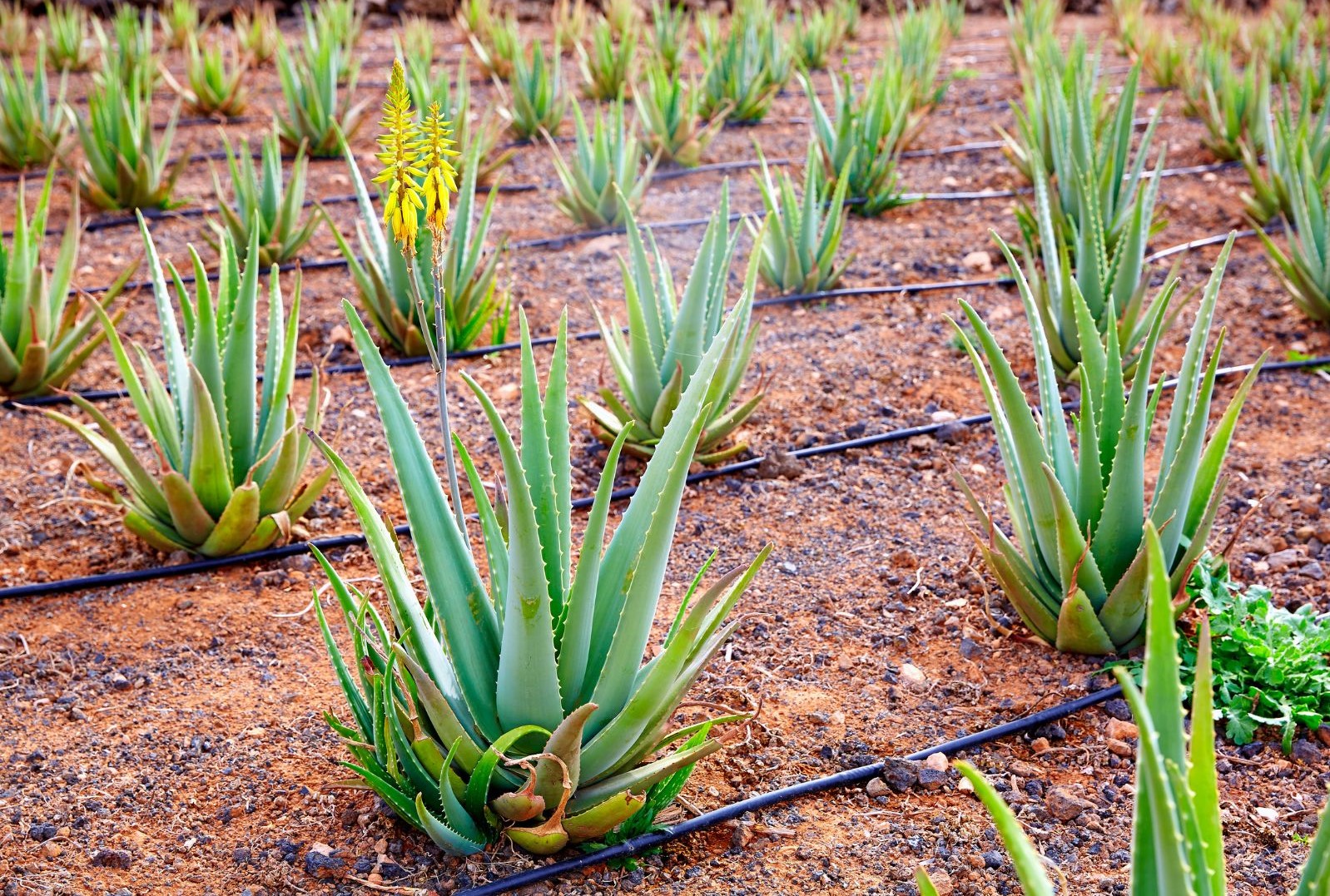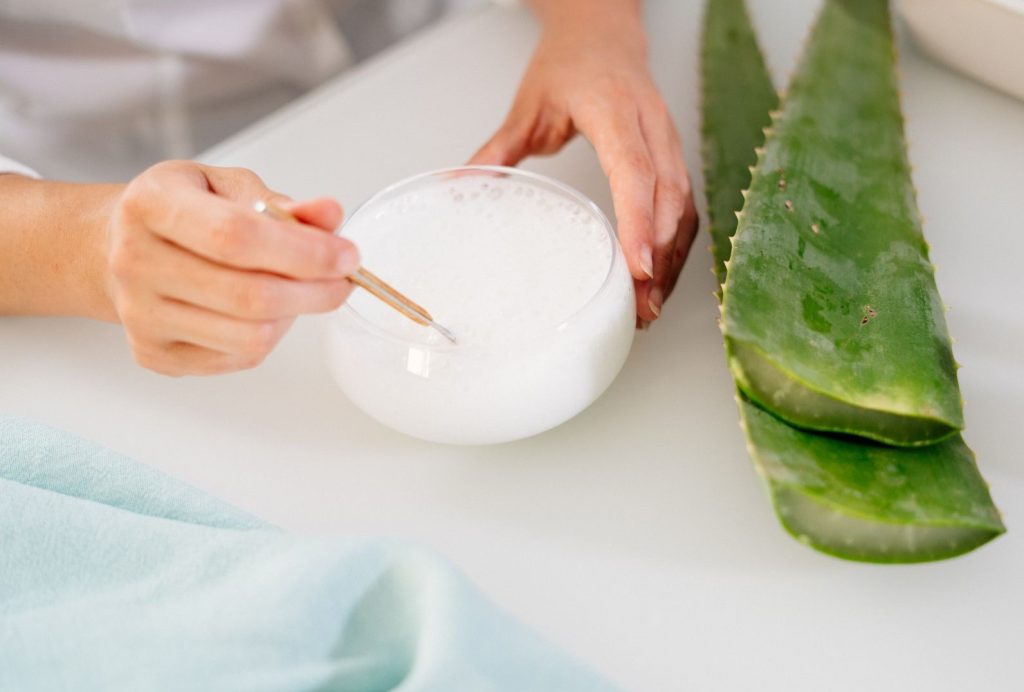Unlocking the Economic Potential of the Aloe vera Value Chain

This post is also available in:
This post is also available in:
![]() Español (Spanish)
Español (Spanish) ![]() العربية (Arabic)
العربية (Arabic) ![]() Ελληνικά (Greek)
Ελληνικά (Greek)
Aloe vera is a succulent plant that originated in North Africa, the Arabian Peninsula, and the Canary Islands, with a rich history of medicinal and cosmetic uses. It is sometimes called the “plant of immortality” due to its long history of usage in medicine and cosmetics. Today, it is among the most widely grown and purchased plants on the market, and with rising demand for organic healthy products, it is experiencing a resurgence in popularity worldwide.
Its versatile nature and wide-ranging benefits have led to the development of a robust value chain that spans various industries. The aloe vera value chain has emerged as a significant contributor to economic growth and sustainable development from agriculture, manufacturing, pharmaceuticals, cosmetics, and exports. Aloe Vera Market size was valued at USD 735.88 Million in 2022 and is projected to reach USD 1271.47 Million by 2030, growing at a CAGR of 6.8% from 2023 to 2030.
In this article, we will explore the various aspects of this value chain and delve into the numerous opportunities it presents.
Interesting facts about Aloe vera – Aloe vera Cultivation and Characteristics
The economic journey of aloe vera starts with cultivation. Aloe vera is relatively easy to grow and requires minimal water and maintenance, making it suitable for cultivation in various climates. Further, the cultivation process is a simple venture with minimal start-up costs and can be harvested all year round, providing farmers with an ongoing source of income.
Root suckers or rhizome cuttings generally propagate it. For this purpose, medium-sized root suckers are chosen and carefully dug out without damaging the parent plant at the base and directly planted in the main field. For rhizome cuttings, after the harvest of the crop, the underground rhizome is also dug out and made in 5-6 cm length cuttings which should have a minimum of 2-3 nodes on them.
It may be cultivated in various climates, needs little effort and upkeep, and is pest-resistant. Aloe vera thrives in warm and dry climates. The ideal temperature for optimum growth is between 20°C to 30°C. Extreme temperatures have a negative impact on the plants: temperatures above 35°C can decrease growth and lead to leave drying and sunburns, while temperatures below 10°C can be detrimental. It also requires well-drained soils of 6.0 or 7.0 PH and 6-8 hours of sunlight. Countries with favorable climates, such as Thailand, Mexico, Dominican Republic, China, India, and South Africa, are among the leading producers of aloe vera.
Due to its perceived health benefits, the demand for aloe vera gel, juice, and extracts has grown substantially in recent years. Aloe vera contains bioactive compounds, including vitamins, minerals, enzymes, and polysaccharides, associated with various health advantages, such as skin health, digestive health, and immune system support. The increasing interest in natural and herbal remedies has fueled the demand for aloe vera, creating economic opportunities for farmers and agricultural businesses.
Aloe vera Processing and Manufacturing
Post-harvest Management of Aloe vera
Once harvested, aloe vera leaves undergo processing to extract the gel or juice. This involves several steps, including washing with salt, filleting, and grinding. The thick green leaves contain gel and latex. The gel consists primarily of water, vitamins, enzymes, amino acids, hormones, minerals, and sugars, most of which are found in the human body. The extracted gel is then stabilized to maintain its potency and increase its shelf life. The gel or juice can be further processed into various products, such as gels, creams, lotions, drinks, and supplements.
Aloe vera processing and manufacturing form a critical component of the value chain. Companies in this stage contribute to the economy by providing employment opportunities, supporting local farmers, and creating marketable products. Moreover, technological advancements and processing methods have led to the development of innovative aloe vera-based products that cater to diverse consumer needs.
Aloe vera-based products – Uses of Aloe vera
Aloe vera‘s value chain extends to a wide range of products that cater to diverse industries and consumer needs. Some of the notable products include:
1. Pharmaceuticals and Medicinal Uses
Aloe vera has a long history of medicinal applications in traditional medicine systems. Its potential as a natural remedy for skin conditions, burns, and wounds has led to its incorporation into various pharmaceutical products. Aloe vera-based creams, ointments, and gels are widely used for treating skin ailments, anti-inflammatory, antimicrobial, and promoting wound healing.
The pharmaceutical industry’s integration of aloe vera into its products has created a substantial economic impact. The global market for aloe vera-based pharmaceuticals is expected to witness significant growth in the coming years, with increasing consumer awareness of natural remedies and a preference for plant-based treatments.
2. Cosmetic and Personal Care Products
The cosmetic industry has also harnessed the benefits of aloe vera. Consumers increasingly prioritize natural and organic products, so the demand for aloe vera-infused cosmetics has risen significantly. This demand has driven product diversification and created lucrative opportunities for African companies to tap into domestic and international markets. Its hydrating, anti-inflammatory, and soothing properties make it a sought-after ingredient in skincare and haircare products. In skincare products, aloe vera’s moisturizing and soothing properties make it a prominent ingredient in creams, lotions, and facial masks. In haircare products, aloe vera-infused shampoos, masks, moisturizers, and conditioners are sought after for their nourishing, natural, and gentle alternatives effects on hair and scalp.
Using aloe vera in cosmetics has opened many economic opportunities for manufacturers, formulators, and retailers. Additionally, as consumers increasingly shift toward eco-friendly and sustainable products, aloe vera‘s natural origin aligns perfectly with organic trends, further enhancing its economic potential.
3. Nutraceuticals and Functional Foods
The nutraceutical industry has embraced aloe vera for its potential health benefits. Aloe vera juices and health drinks: known for their potential digestive and immune system benefits, have gained popularity among health-conscious consumers. Aloe vera extracts are used to formulate dietary supplements, functional foods, and beverages, capitalizing in dietary supplements and functional foods. These products often claim to support digestion, improve gut health, and boost the immune system.
As the interest in preventive healthcare and wellness continues to rise, the demand for aloe vera-based nutraceuticals will likely expand. This provides immense economic potential for research, development, and manufacturing companies.
4. Other Benefits of Aloe vera for the Farmer
Export Opportunities
The Aloe vera value chain has also opened up promising export opportunities. With the growing global interest in natural and herbal remedies, especially in Asia, Europe, and India, aloe vera-based products have entered international markets. India and Africa have become significant exporters of Aloe vera gel, extracts, and finished products.
The export of Aloe vera products earns valuable foreign exchange for the country and strengthens India’s position as a reliable supplier in the international market.
Employment Generation and Rural Development
The Aloe vera value chain has contributed to rural development by generating employment opportunities in cultivation and processing. As Aloe vera cultivation requires manual labor, it has provided additional income for agricultural communities, especially in regions with limited farming options.
Furthermore, the establishment of processing units in rural areas has encouraged small-scale entrepreneurship and industrial growth, empowering local communities and boosting the overall economic development of these regions.
Concluding remarks
The Aloe vera value chain combines traditional wisdom and the modern economic treasure trove of opportunities. From its cultivation in arid landscapes to the production of diverse products for various industries, Aloe vera has carved a niche in both domestic and international markets. It encompasses various industries, from agriculture and processing to pharmaceuticals, cosmetics, and nutraceuticals.
Its diverse applications and natural appeal have contributed to the widespread adoption of Aloe vera-based products globally. As consumer awareness regarding health, wellness, and sustainability grows, the economic potential of the aloe vera value chain is poised for even greater heights.
By investing in research, sustainable cultivation practices, and innovative product development, stakeholders within the aloe vera value chain can continue to unlock new economic growth opportunities and contribute to consumers’ well-being worldwide.
Further reading
Sustainable Use of Bagasse: Harnessing the Potential of Sugarcane Waste
Unlocking the economic potential of the Aloe vera value chain
References:
https://sdginvestorplatform.undp.org/market-intelligence/aloe-vera-farming
Wintola OA, Afolayan AJ. The antimicrobial and anti-inflammatory activities of the isolated compounds from Aloe ferox Mill. African Journal of Biotechnology. 2011;10(36):7005-7011.
Owolabi MS, Jaja SI, Francis IO, Otamere HO. Evaluation of wound healing activity of Aloe vera gel on cutaneous ulcer. The Nigerian Journal of Plastic Surgery. 2010;6(2):10-15.
Mgbeje BI, Anene BM, Obikwelu CO. Chemical composition and medicinal properties of Aloe vera Linn: A review. International Journal of Biotechnology and Allied Sciences. 2016;3(2):25-35.
Kruger M, Smith C, Steyn DG. The efficacy of Aloe vera gel in the treatment of oral lichen planus: a randomized controlled trial. Journal of Clinical and Diagnostic Research. 2014;8(11):ZC47-ZC50.
Amoo SO, Aremu AO, Van Staden J. In vitro plant regeneration, secondary metabolite production, and antioxidant activity of micro propagated Aloe arborescens Mill. Plant Cell, Tissue, and Organ Culture (PCTOC). 2012;108(3):503-511.
Rajput R, Makwana A, Patel P. Aloe vera: A valuable wonder plant for food, medicine, and cosmetics. Food Science and Human Wellness. 2020;9(3):265-274.
Ahlawat KS, Khatkar BS. Processing, food applications and safety of aloe vera products: a review. Journal of Food Science and Technology. 2011;48(5):525-533.
Surjushe A, Vasani R, Saple DG. Aloe vera: a short review. Indian Journal of Dermatology. 2008;53(4):163-166.
Peiris-Pagès M, Smith DL, Gyorffy B, Sotgia F, Lisanti MP. Aloe vera induces intrinsic and extrinsic pathways of apoptosis in human breast cancer cells. Nutrition and Cancer. 2015;67(1):91-99.
Devaraj S, Yimam M, Brownell LA, Jialal I. Effects of Aloe vera supplementation in subjects with prediabetes/metabolic syndrome. Metabolic Syndrome and Related Disorders. 2013;11(1):35-40.









































































